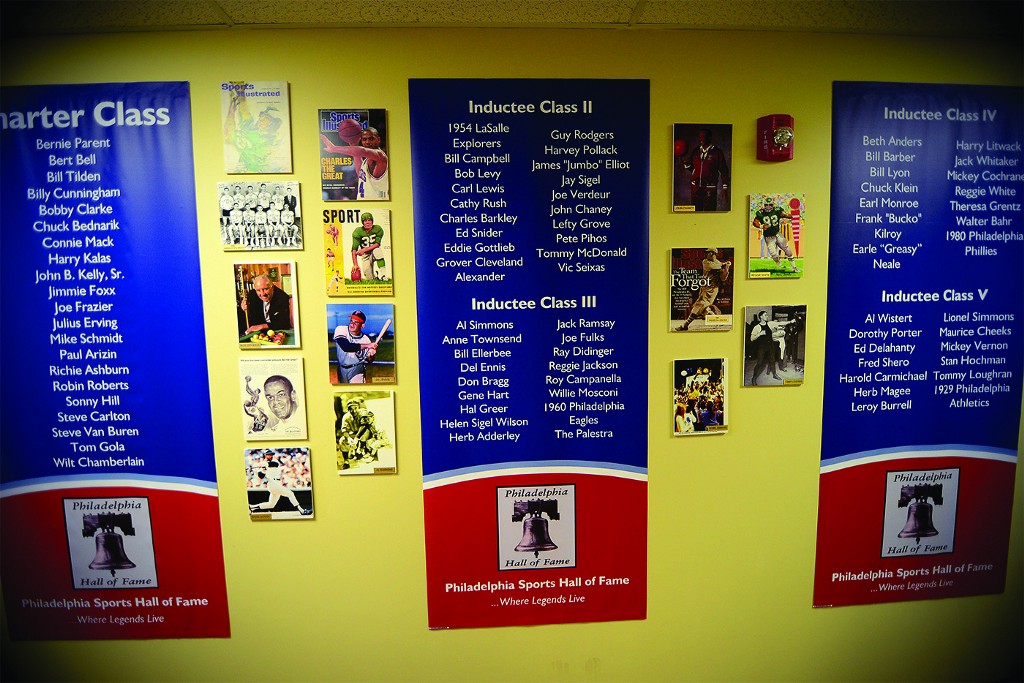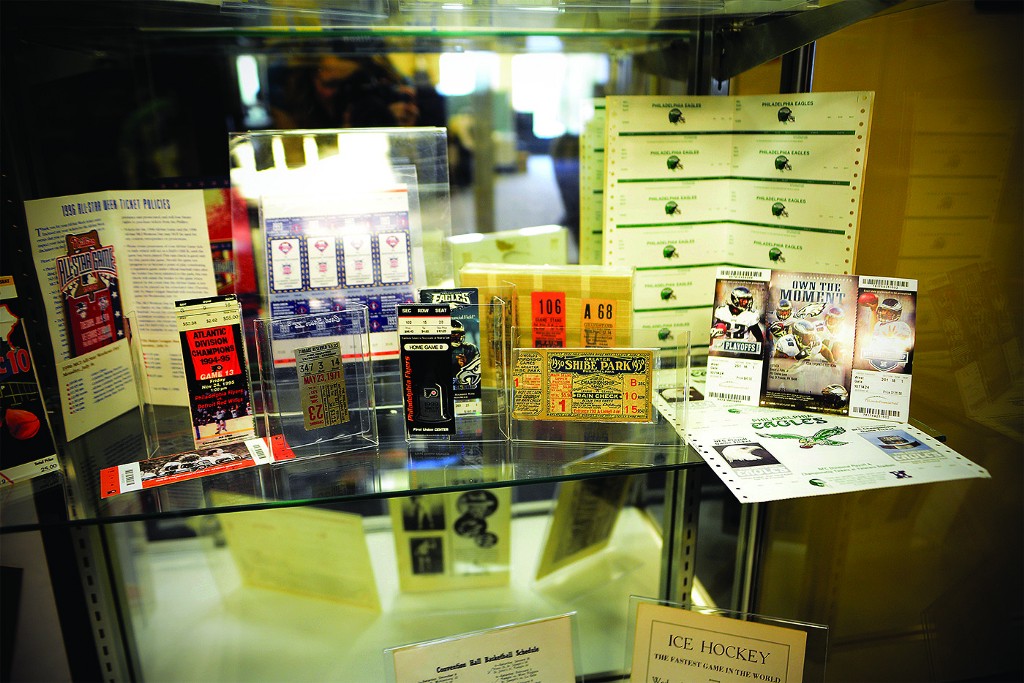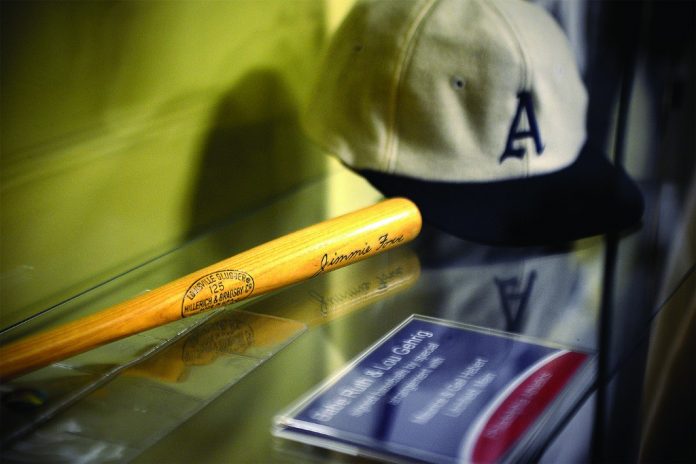Philly sports on display: The Philadelphia Sports Hall of Fame was developed by Ken Avallon in 2002 and inducted its first class in 2004. Now with close to 200 members, the Hall continues to grow. In a partnership with Spike’s Trophies on Grant Avenue, the Hall of Fame displays a Preview Gallery of rotating exhibits to better educate the public on a rich sports history that dates back to the late 1800s. TIMES FILE PHOTO
In an athletics-crazed town like Philadelphia, the natural assumption is that a commemorative sports Hall of Fame would have been in existence for at least a handful of decades.
Believe it or not, this wasn’t the case, and Ken Avallon couldn’t believe it. So the genesis of such a sensible concept began like most things that are meant to be: with an idea.
It was May 2002, and like most days for Avallon, a technology consultant project manager by trade, it began by reading the sports section of the Philadelphia Inquirer. He came across a “Morning Bytes” article by columnist Frank Fitzpatrick which posed the simple questions:
How about a Hall? Why doesn’t this city have a Philadelphia Sports Hall of Fame?
Great question.
“With a sports history dating back to the late 1800s, I figured there had to be a sports Hall of Fame in Philly,” said Avallon, who would become the founder and president of what would ultimately become the city’s sports Hall. “I did some research trying to track it down, and I found some niche ones for boxing, the Big Five, the Philadelphia Jewish Sports Hall of Fame, but nothing that encompassed all sports. I got together with some family and business acquaintances and tried to put something together.”
The Philadelphia Sports Hall of Fame Foundation was registered as a nonprofit corporation a month after Avallon read Fitzpatrick’s column, and the idea continued to rapidly develop behind the scenes throughout the rest of 2002. Avallon, who had no real background in sports besides his general fandom, applied his business training to the concept, and contacted other regional sports Halls of Fame in New York, Texas, Alabama, Virginia and Mississippi, among others, to get pointers on what worked and what didn’t while undertaking such an establishment.
He also began reaching out to local sportswriters, authors, historians and coaches who had been around for input, and a list of 41 names was produced for possible induction for the Hall of Fame’s inaugural class. The first media coverage came in June 2003, and two months later, Avallon and company had elected the Hall of Fame’s charter class. In February 2004, Chuck Bednarik, Steve Van Buren, Robin Roberts, Joe Frazier, Harry Kalas, Paul Arizin and Sonny Hill were all in attendance to be inducted for a complete class of 21 individuals, which also included Bernie Parent, Wilt Chamberlain, Julius Erving, Connie Mack, Richie Ashburn, Steve Carlton, Bobby Clarke, Mike Schmidt and Tom Gola.
“It was just such a natural fit to recognize these folks,” Avallon said. “That first class worked out more than we had the right to expect, though. At one level, we were a bunch of nobodies. We had no right to expect anything, but we weren’t thinking that way at the time; it just seemed so obvious and made so much sense. It was real gratifying to pull it off, that first night in February 2004, and it’s kind of been a real upward arch since.”
In total, 180 total members spanning 11 classes have been inducted. The names include individual athletes, total teams, executives, media members and miscellaneous things such as the Palestra and Penn Relays. Anybody can nominate somebody or something for induction, and eligibility requirements state that members can be natives who went on to star elsewhere, or those from other places who left an indelible mark on Philadelphia’s rich and expansive sports history.
Currently, the Philadelphia Sports Hall of Fame is headquartered at Spike’s Trophies on Grant Avenue after a stint in Northern Liberties ended due to rising property values as the area was re-gentrified. And while Spike’s houses some memorabilia and rotating exhibits in what is known as a “Preview Gallery,” Avallon stated that a Hall of Fame is more than just a museum space devoted to showcasing artifacts and mementos.
“The Hall of Fame is conceptual, not just a brick and mortar building or museum,” Avallon said. “The museum business is not a moneymaking one. We would like to have a 20,000-square-foot space and we’ve talked about that, but you need corporate grants and sponsorship, and over time that kind of dried up. In that sense, we were victims of our own success. That’s where the Preview Gallery at Spike’s is a real big accomplishment for us.”
Avallon said it’s a “constant effort on our part for potential sites and partners” to improve the Hall of Fame in its tangible form. However, in a more abstract way, Avallon and his team couldn’t be prouder of what the Hall of Fame has become over the last dozen years. In addition to the big names enshrined, Avallon said a tremendous sense of pride is showcasing the lesser-known names. For example, he highlighted Joe Verdeur, a swimmer who graduated from North Catholic in 1944 and went on to set 21 American records and won a gold medal in the 1948 Olympic Games in the 200-meter breaststroke.
“He was like the Mark Spitz or Michael Phelps of the 1940s,” Avallon said. “Joe passed away, but we worked with his family to be able to display his gold medal and the trunks he wore as one of our exhibits. It’s better to put it out there and educate people instead of it sitting in an attic or basement somewhere. The public can see it, and we provide a forum for recognition.”
Avallon and company are currently at work on the Hall of Fame’s 12th class, and he hopes it continues to evolve and grow in the future as it has since the initial idea in 2002. While Spike’s continues to donate the space rent-free, Avallon said he and his partners will continue looking for a permanent home in more of a larger-scale museum setting that makes pertinent business sense.
“At Spike’s, you look at what they do and you immediately think it’s run by people who have been working in the museum business their entire lives, especially with their attention to detail,” Avallon said. “So we’ve been deliberately conservative in that way. The business model is built in with a sustainable revenue stream, but it also entails some kind of endowment. That’s the struggle we’ve run into. Ideally, we’d love an angel who would give us ‘X’ number of dollars to do what we want, but that’s just not realistic at this point.”
Regardless of how much of the Hall of Fame exists tangibly at any given point these days and how much it remains a conceptual honor, the most important fact is that it exists, something that couldn’t be said at the beginning of the last decade. And the Hall of Fame appeals to all local sports fans, be it the four main professional teams, fans of collegiate athletics and those who may be interested in less mainstream sports.
“Looking at the sports heritage and history of our city, the Hall of Fame encompasses sports at all levels,” Avallon said. “If you get outside the ‘big four,’ you see Philadelphia has a tremendous boxing history, a rowing history with Boathouse Row, a track history with the Penn Relays and some really great historical golf tournaments. There’s amazing tennis and field hockey and lacrosse history; you might not be a big Eagles fan but you like boxing or rowing. We provide recognition far beyond major sports.
“People can relate to it on more of a visceral and personal level. Whatever team or player it might be, we offer that connection to people. We didn’t think about that when we were first getting started, but what we realize now is that all sports at all levels have a broad-based appeal. That, in one way, is the essence of what we do.”
The Hall of Fame is based at Spike’s, a trophy and awards shop at 2701 Grant Ave. The public is invited to view the gallery Saturdays from 9 a.m. to 1 p.m. ••

Philly sports on display: The Philadelphia Sports Hall of Fame was developed by Ken Avallon in 2002 and inducted its first class in 2004. Now with close to 200 members, the Hall continues to grow. In a partnership with Spike’s Trophies on Grant Avenue, the Hall of Fame displays a Preview Gallery of rotating exhibits to better educate the public on a rich sports history that dates back to the late 1800s. TIMES FILE PHOTO

Philly sports on display: The Philadelphia Sports Hall of Fame was developed by Ken Avallon in 2002 and inducted its first class in 2004. Now with close to 200 members, the Hall continues to grow. In a partnership with Spike’s Trophies on Grant Avenue, the Hall of Fame displays a Preview Gallery of rotating exhibits to better educate the public on a rich sports history that dates back to the late 1800s. TIMES FILE PHOTO





